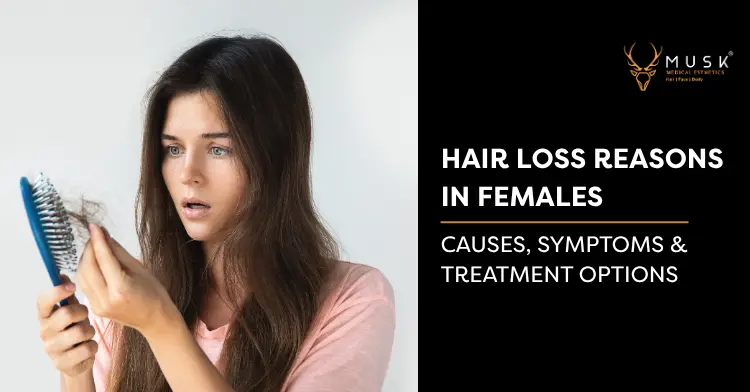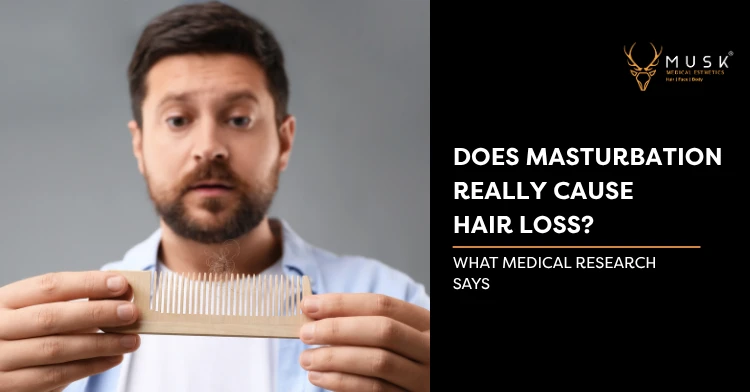Does Derma Roller Really Work for Hair Loss? Evidence, Benefits & Limitations

Navigating the world of hair loss solutions can feel overwhelming. Yet, a surprisingly simple tool has gained significant traction, backed by solid science: the derma roller. So, can this device truly help you win the fight against thinning hair? The evidence points to yes.
When used with care and precision, a derma roller can awaken dormant hair follicles and create a healthier environment for growth. It’s a technique that puts the power of your body's own healing abilities to work for you.
At Musk Clinic, our mission is to demystify hair restoration. We combine advanced technology with the world-renowned expertise of our founder, Dr. Anand B. Shah, to deliver results that don’t just change hairlines—they change lives.
This guide offers a deep dive into the world of microneedling. We'll explore how it works, what it can realistically achieve, and how to use it safely, empowering you to take the next step on your journey to renewed confidence.
What is a Derma Roller, and How Does It Work for Hair Loss?
Imagine a small, handheld device with a wheel covered in hundreds of tiny, fine needles. That’s a derma roller. The process, called microneedling, involves rolling these needles over your scalp. It sounds technical, but the concept is beautifully simple: it harnesses your body’s natural healing instincts.
When the needles create controlled, microscopic punctures in the skin, they signal your body to begin a repair process. This targeted response is what directly benefits your hair follicles in several powerful ways:
- It Rebuilds with Collagen: The micro-injuries trigger a surge in collagen and elastin production. Collagen is the scaffolding of your skin and strengthening it around the follicle creates a more secure, healthier base for every strand of hair.
- It Boosts Nutrient Supply: Your body rushes more blood to the treated area to heal it. This increased circulation is like opening a superhighway for oxygen and vital nutrients to flow directly to your hair follicles, nourishing them from within.
- It Awakens Growth Factors: Microneedling stimulates the release of key growth factors like VEGF and PDGF. It also activates stem cells within the follicles. Think of this as a wake-up call for dormant follicles, encouraging them to re-enter the active growth phase.
- It Supercharges Topical Treatments: The tiny channels created by the needles act as express lanes, allowing topical treatments like Minoxidil to penetrate deeper and work far more effectively. This synergy is often the key to unlocking dramatic results.
Is a Derma Roller the Right Choice For You?
Before you begin, it’s important to know if derma rolling is a suitable solution for your specific situation. While a professional diagnosis is always best, you are likely an ideal candidate if:
- Your Hair Loss is in the Early Stages: Microneedling excels at reviving thinning areas and thickening existing hair. It’s perfect for androgenetic alopecia (pattern baldness) or general thinning, but less effective on completely bald areas.
- You Have Realistic Expectations: Understand that this is a marathon, not a sprint. Results are gradual and require months of consistent effort. This is a powerful tool for improvement, not an instant cure.
- Your Scalp is Healthy and Clear: To avoid complications, your scalp must be free from inflammation. If you have active psoriasis, eczema, dermatitis, or any open sores, derma rolling must be avoided until these conditions are resolved.
- You're Committed to the Process: Success hinges on consistency and proper technique. You must be willing to follow a safe, sterile, and regular routine to see the benefits.
Professional vs. At-Home Microneedling: Understanding the Difference
The choice between a DIY approach and a clinical treatment is a crucial one. Both have their place, but they offer very different levels of intensity and results.
1. At-Home Derma Rolling
This is the accessible, entry-level option that you perform yourself.
- The Tool: At-home rollers use shorter needles, typically 0.25mm to 0.5mm. This length is designed with user safety in mind, focusing on surface-level stimulation and enhancing product absorption.
- The Goal: It’s excellent for maintaining scalp health, boosting the effectiveness of your topical serums, and providing a gentle stimulus for hair growth. Think of it as a valuable part of your supportive hair care routine.
- The Catch: The shorter needles cannot penetrate deep enough to trigger the powerful collagen induction and stem cell response needed to address more significant hair loss. The risk of user error, improper sterilization, or skin damage is also higher.
2. Professional In-Clinic Microneedling
Performed in a sterile, controlled environment by a trained specialist.
- The Tool: Professionals use medical-grade devices, like a Dermapen, which have adjustable needles that can reach depths of 1.0mm to 2.5mm. This precision allows for a treatment tailored to your exact needs.
- The Goal: The deeper penetration creates a much more robust healing response. This leads to superior collagen production, more effective growth factor stimulation, and ultimately, more significant and visible hair regrowth.
- The Advantage: The procedure is safe, sterile, and often combined with other powerful therapies like Platelet-Rich Plasma (PRP). This combination delivers concentrated growth factors from your own blood directly to the follicles, offering the highest level of non-surgical hair restoration.
For anyone serious about achieving substantial hair regrowth, professional microneedling is the gold standard.
Why Should you Combine a Derma Roller with Minoxidil?
The support for microneedling goes beyond online testimonials. A landmark study published in the International Journal of Trichology put the technique to the test.
Researchers took 100 men with male pattern baldness and split them into two groups. Group one used only Minoxidil lotion. Group two used Minoxidil lotion and had a weekly professional microneedling session. The 12-week results were definitive:
- The group combining microneedling with Minoxidil saw a dramatically higher increase in hair count.
- An overwhelming 82% of participants in the combination group reported over 50% improvement.
- By comparison, a mere 4.5% of the Minoxidil-only group saw a similar level of improvement.
This research confirms that microneedling is not just a standalone treatment; it is a powerful amplifier that can make good treatments great.
Your Step-by-Step Guide to Safe At-Home Derma Rolling
If you're starting with an at-home roller, safety and precision are everything. Follow these steps without compromise.
Step 1: Select Your Tool Wisely Choose a high-quality roller with titanium needles between 0.25mm and 0.5mm. Avoid anything longer for home use to prevent injury.
Step 2: Sterilize, Every Single Time This is non-negotiable. Submerge the roller head in 70% isopropyl alcohol for 5-10 minutes before and after each use. Let it air dry completely. Never use boiling water or share your roller.
Step 3: Prepare a Clean Canvas Always start with a freshly washed and completely dry scalp. This prevents you from pushing bacteria into your skin.
Step 4: Master the Rolling Technique Work in sections. Part your hair to expose the scalp.
- With gentle pressure, roll vertically 6-8 times.
- Lift the roller, then roll horizontally 6-8 times.
- Lift again, and roll diagonally 6-8 times.
- Lifting the roller between direction changes is key to preventing scratches. Once a section is done, move to the next.
Step 5: Allow Your Scalp to Rest Your scalp will look and feel like it has a mild sunburn. This is normal. Let it breathe. Do not apply any products, especially Minoxidil or anything with alcohol, for at least 24 hours to avoid severe irritation.
Step 6: Clean and Store Properly After use, rinse the roller under hot water to clean off any skin cells. Then, repeat the full alcohol sterilization process. Once dry, place it back in its protective case to keep the needles pristine.
What is the Right Frequency for Derma Rolling?
How often you should roll depends on your needle length:
- 0.25mm: Gentle enough for use every other day.
- 0.5mm: Requires more healing time. Use it 1-3 times per week, max.
Remember, your scalp needs time to repair and regenerate. Overdoing it will only lead to inflammation and could set you back. Consistency is more important than frequency.
Being Aware of the Limitations and Potential Risks
While effective, derma rolling requires respect for the process. Be aware of the risks:
- Common Irritation: Expect temporary redness, itching, or a slight swelling. This should resolve within a day.
- Infection Risk: The most significant risk comes from poor hygiene. An unsterilized roller can cause a serious scalp infection, which could worsen hair loss.
- Excessive Pressure: Applying too much force can cause bleeding, scarring, and damage to the hair follicles. It should feel prickly, not painful.
- Hair Breakage: Be careful not to tangle longer hair in the roller. Working in clean sections helps prevent this.
Creating a Powerhouse Combination for Maximum Results
Derma rolling shines brightest when it’s part of a team.
- Derma Roller + Minoxidil: This is the classic, evidence-backed duo. Microneedling opens the door for Minoxidil to get to work deeper within the scalp. Just honor the 24-hour waiting period after rolling.
- Derma Roller + PRP Therapy: This is the ultimate non-surgical combination, performed in-clinic. Professional microneedling prepares the scalp to receive a powerful application of PRP, a concentrate of your own body's growth factors, for truly supercharged results.
A Realistic Timeline: When Can You Expect to See Changes?
Patience is your greatest asset on this journey. Hair growth is a slow, cyclical process.
- Months 1-3: The focus is on scalp health and reducing shedding. You are laying the groundwork for new growth, but you won't see it yet.
- Months 3-6: The first exciting signs may appear. Look for fine, vellus hairs (or "baby hairs") sprouting in the treated areas. Your existing hair might feel a bit fuller.
- Months 6-9: The results become more apparent. Those new hairs will have had time to mature and thicken, visibly improving your hair's density.
- Months 12+: After a year of consistent treatment, you can fully appreciate the cumulative effect of your efforts on your hair's thickness and coverage.
Why Expert Guidance Matters: The Musk Clinic Difference
Embarking on a hair restoration journey is a profound step. At Musk Clinic, we believe expert guidance is not a luxury—it is essential. Our patient-first approach ensures that your treatment plan is 100% customized to you. As the first clinic in India to introduce the ARTAS 9x Robotic Hair Transplant, we are defined by our commitment to technological excellence and unparalleled precision.
While at-home derma rolling is a fantastic supportive tool, we invite you to have a conversation with us. Let’s explore how professional-grade treatments, from advanced microneedling with PRP to robotic hair transplants, can provide the significant, lasting results you are looking for. At Musk Clinic, we don’t just restore hair; we help you step back into the world with renewed confidence.











